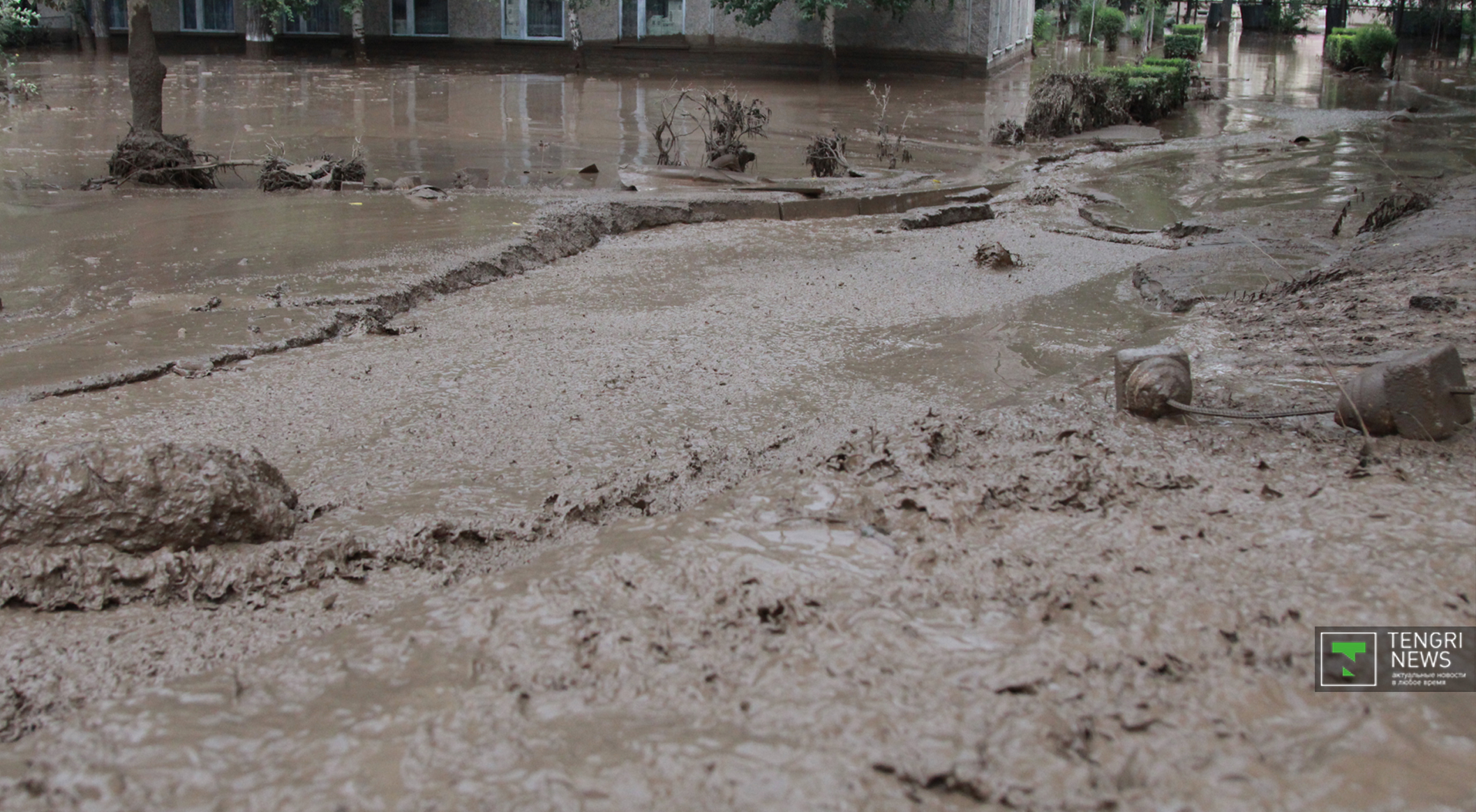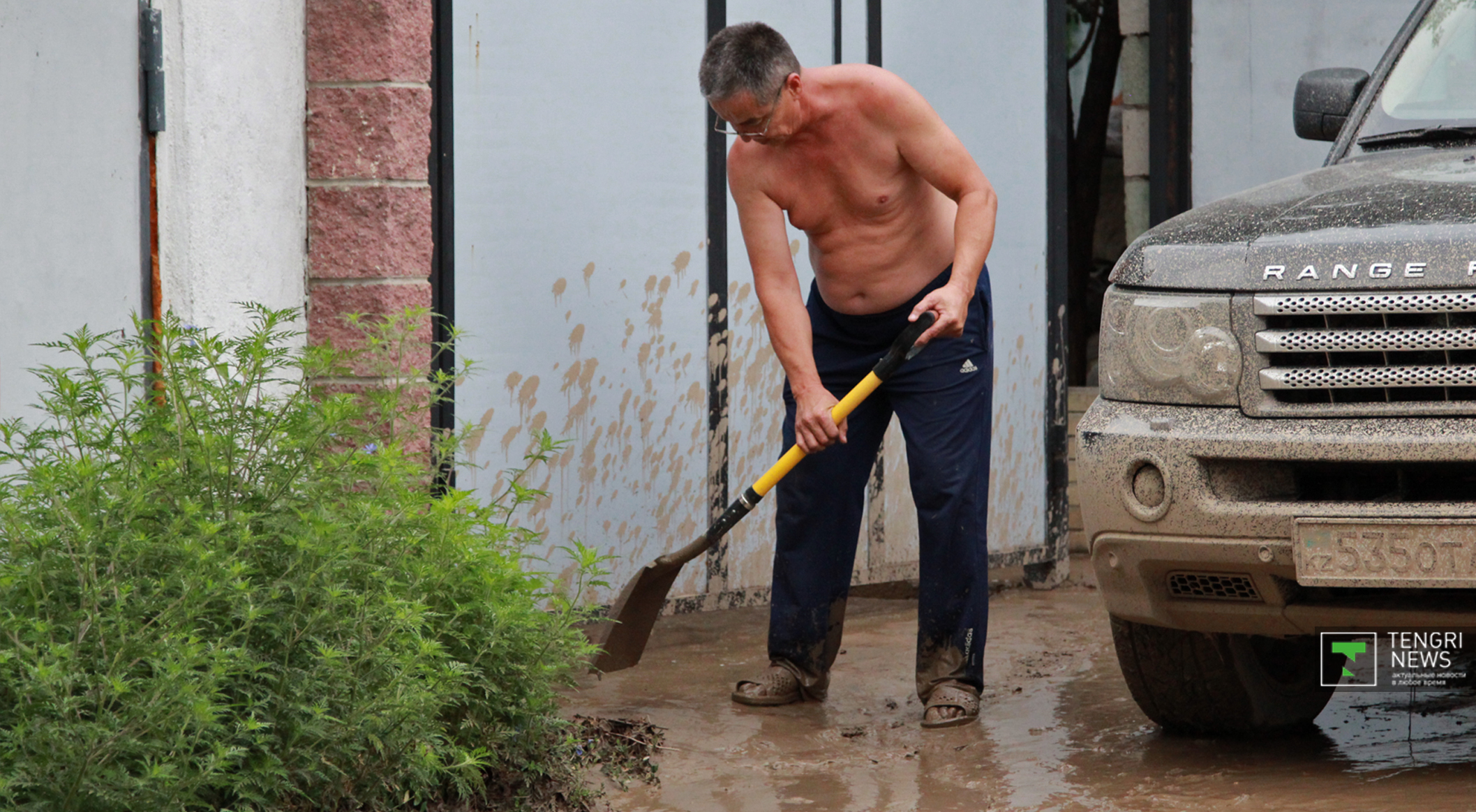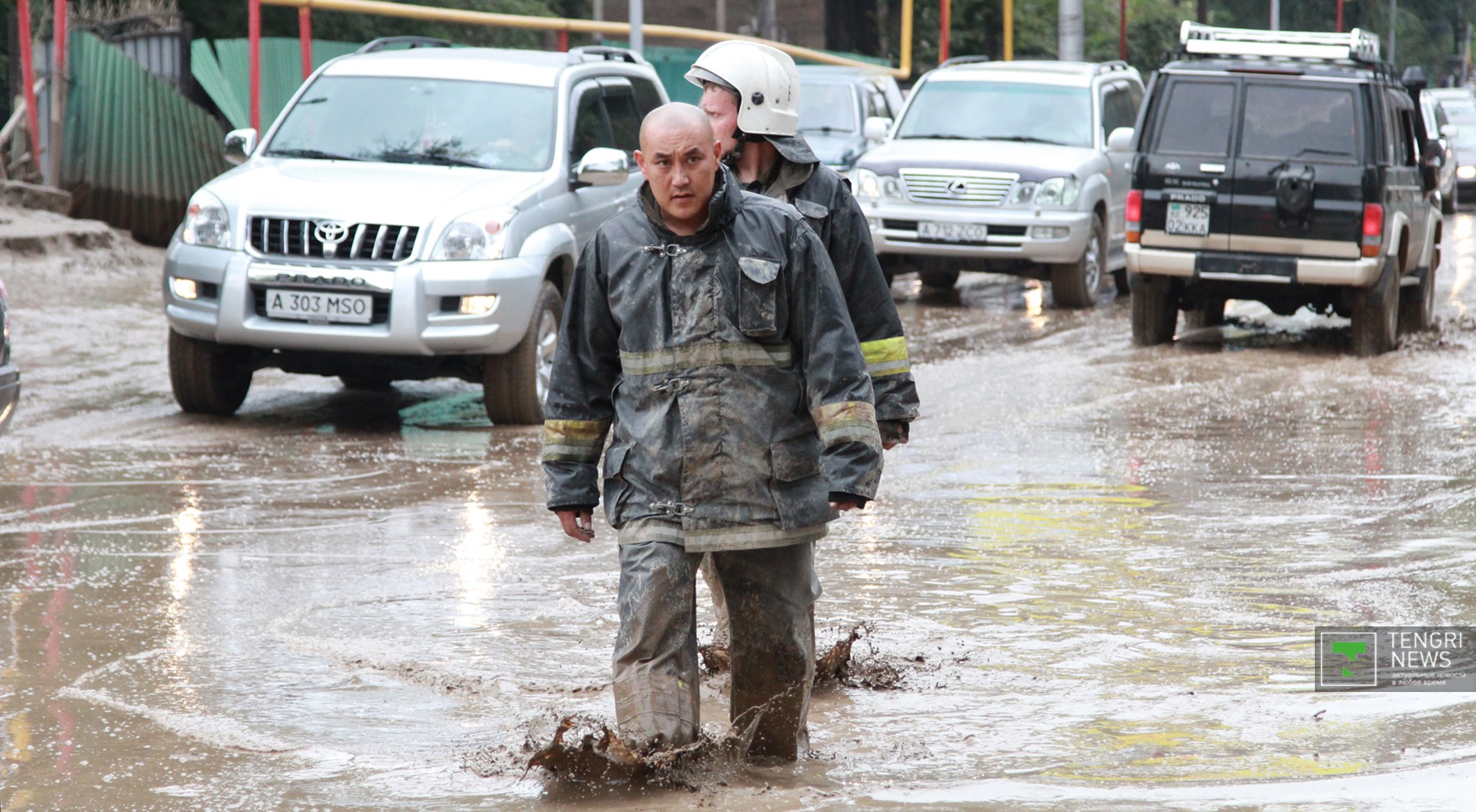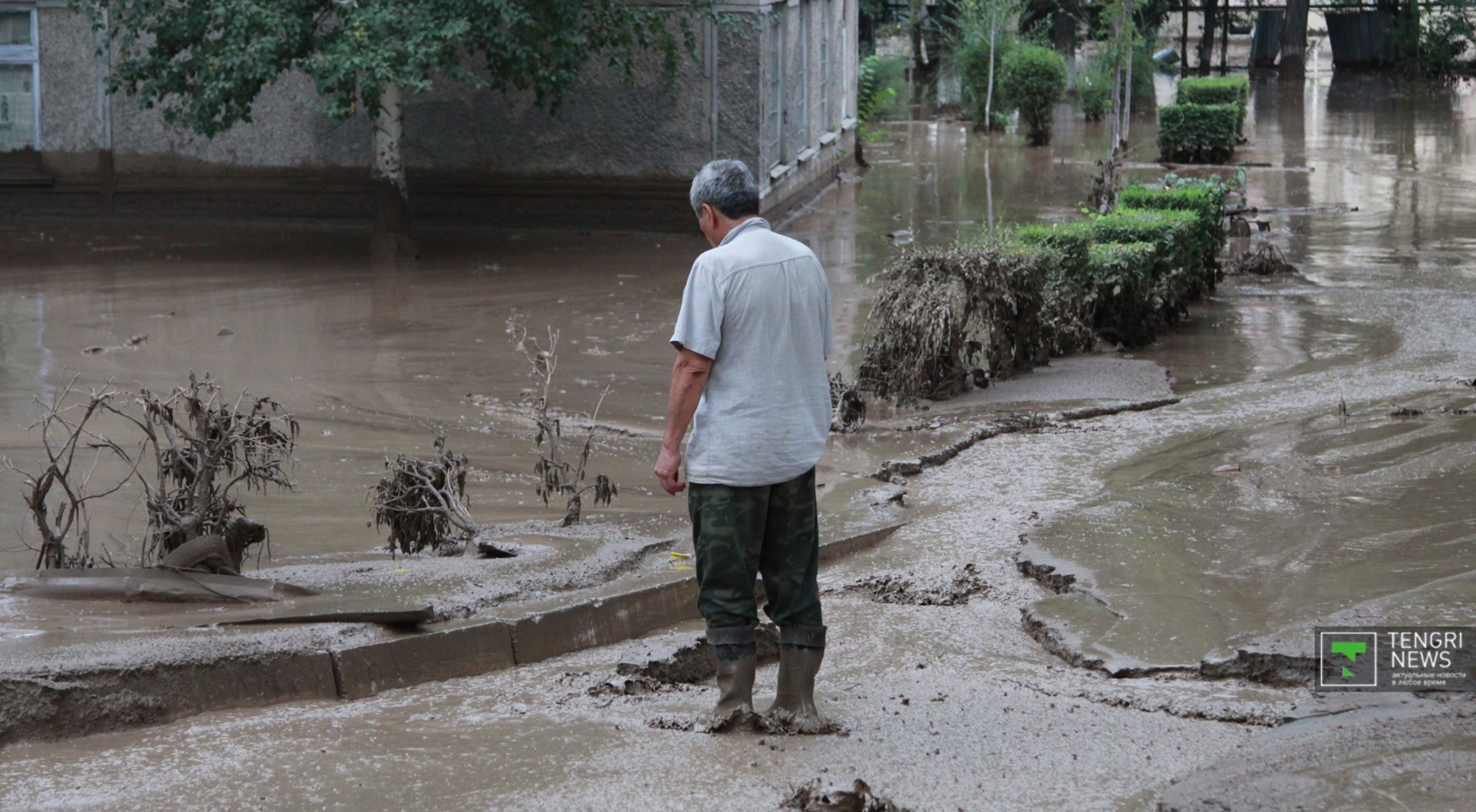Kazakhstan's largest city of Almaty surrounded by a majestic snow-capped mountains range has been hit by a mud flow on July 23. At around 2.15 a.m. morainic lake Bezymyannoye at Kargaly glacier that held 40,000 cubic meters of water burst releasing part of the water downhill. This triggered a series of mud flows, with part of them overtopping the dam on the Kargaly River.
Auezov, Nauryzbai and Alatau districts of the city were among worst-hit areas. 1036 people including 51 children were immediately evacuated to the building of #176 secondary school as well as Nauryzbai district’s administration.
6 people were taken to the hospital, whereas another 78 were were provided first medical aid.

©Vladimir Prokopenko
Right after the incident, Kazakhstan's Deputy Prime Minister Berdybek Saparbayev and Kazakhstan's Deputy Internal Affairs Minister Vladimir Bozhko arrived at the scene.
In addition, Almaty's Mayor Akhmetzhan Yessimov along with the city's Emergency Department employees flew over the mud flow hit areas on a helicopter, to confirm that the dam was not damaged.

Photo courtesy of Nurken Khalykbergen
Although mudslide did not claim any lives, the damage incurred is still very significant. The work is now underway to help people handle the aftermath of the disaster. 1,879 people as well as 311 units of equipment and 2 helicopters are involved in the operation. To this day, they have helped clean 71 yard and houses and 21 streets. However, some of the streets in Nauryzbai district are so narrow, that it was impossible to use large vehicles there and people have to clean the streets on their own.
Apart from the Emergency Department, the National Guard of the Minister of Internal Affairs, Ministry of Defense, Almaty's Department of Internal Affairs, local executive bodies, the city's organizations and many volunteers are helping victims in eliminating the aftermath of the mud flow.
According to one of the volunteers Ilyas Mukhamedzhan, a lot of people, even families along with their children are coming to provide assistance to families affected by the mud flow. Around 100 people are now working at the site. But there are still some problems. "Some of the streets are still littered with stones. It is hard to get to these streets. Last night we went to one such street, brought them water and food. No one could get there during these three days. People are left without electricity, gas and water," he shared.

©Vladimir Prokopenko

©Vladimir Prokopenko
Around 200 homes were left without water, electricity and gas, thus being deprived of an opportunity to prepare food. Kazakhstan's Red Crescent Society branch asked Kazakhstanis to provide all the help they could to their fellow citizens. In particular, mud flow victims need food, water and big size rubber boots. The Red Crescent Society headquarters to assist the victims was opened at Saudabai restaurant located 100 meters away from #192 secondary school on 50 Kali Nadyrov Street.
Moreover, some of the stores in the afflicted areas increased prices for basic products, Ilyas said. "There is such tendency, unfortunately. It turns out that these products are cheaper in the town than here," he said.
Meanwhile, most residents are still shocked by what happened. "I felt anxious that night. I could not sleep, although I new had to get up at 5 in the morning. I fell asleep somehow, while my wife was still sitting at the computer. At around 2.30 a.m, she heard a low rumbling. She thought it was rain or hail. Understanding that there was something going on, she began to wake the children. When they were just about to go outside, the first wave came down," one of residents Sundet Satpayev told Today.kz.
"Fridge, computer and TV - everything got soaked. The first thing we thought about was surviving, and then when everything was over, we were very upset about our garden. We have just recently planted some cucumbers, tomatoes, apple trees and raspberries. I also lost my mobile phone. Now I cannot even notify my boss that I am not going to go to work in the next days," he said.
"It is a nightmare, something horrible. I was born here in Kamenka (village in Nauryzbai district), but I have never seen anything like this in my entire life," one of the witnesses told Tengrinews.
According to the Emergency Situations Committee of Kazakhstan’s Internal Affairs Ministry, the mud flow was triggered by the lingering excessively hot weather in the area, which made the glacier melt faster and overfill the Bezymyannoe Lake, after which a large mass of water along with debris flowed down the Kargalinka mountain river.
The Committee informed that more than 18,000 cubic meters of mud had been removed from the area over the past days.
Most people have returned to their homes. 55 evacuees were accommodated to four hotels. "After inspection of 828 houses, it was concluded that seven houses were partially destroyed, 429 were flooded, including the building of two secondary schools and one outpatient clinic. The commission continues estimating the number of houses that were affected and assessing the damage," it said.

©Vladimir Prokopenko


©Vladimir Prokopenko

©Vladimir Prokopenko
Just two days later, a danger of another mud flow emerged at the opposite edge of the city along the Talgar River due to heavy rains high in the mountains and intense melting that increase of water flow rate in the river to 27 cubic meters per second.
515 people, mostly children, were immediately evacuated from area near the Talgar river that has summer camps in plenty. Luckily, the dam stopped the mud slide, with all of it ending up in the mudflow storage reservoir located down the river.
The Talgar River dam. ©Tengrinews
According to the head of the regional Emergency Department Sabit Bitayev, the situation around the river is stable now. The dam is able to withstand 8 million cubic meters of mudwater, he said, while the current flow rate stands at 29 cubic meters.
Kazakhstan’s leading expert in mud flow protection, Doctor of Geography and member of Russian Mudflow Association Boris Stepanov told Krisha.kz that Thursday's mud flow was not like anything before. “The mud flow that came down on the night of July 23 was unusual, because the mud was very liquid. I think that it (mud) was going faster than other components. Once it reached the dam, it started flowing through while the larger components of the mud flow (stones and debris) were only entering the mudflow storage reservoir. Due to the high slope of the valley and the density of the mud, the liquid part that broke through the dam created a new mudflow below the dam,” he explained.
According to him, the dam served its purpose properly, because it did not let all the solid component down onto the city.
Boris Stepanov said that mudflow could potentially reach any area located higher than Al Farabi Avenue. In fact, all buildings situated 10 meters away from the river are at the highest risk.
Almaty city is protected from mud flows by three dams installed on the Malaya Almatinka, Bolshaya Almatinka and Kargalinka rivers and according to the expert, all of them are in a good condition, but the problem lies in the fact that all three dams are only capable of withstanding one mud stream. "There is still no backup plan in case the mud storage reservoir becomes full. Such storage poses the greatest danger for the city, since it is not designed to safely discharge the mud flow mass. If the dam fails to hold it, it will lead to tragic consequences for the city's residents," he warned.
According to the professor, Almaty is still in danger, because there are other moraine lakes, which could burst in any moment. "Therefore, it is necessary to drain the lakes. Currently, Kazselezaschita (mud flow protection service) uses a siphoning method, that is, they discharge extra amounts of water to avoid overflowing of the lake. But it is possible to lower the water level by only around 5 meters at a time. In addition, a lake can burst in its underground, as it happened now," he said.
Following the incident, the city's Mayor Akhmetzhan Yessimov stressed the necessity to build new mud flow protection facilities on the Aksai and Kumbel rivers as well as to strengthen the Mynzhylky dam located 4 km away from Shimbulak skiing resort. In addition, he instructed to conduct a study the changes in the glaciers and moraine lakes due to the abnormal weather conditions.
Throughout its history, Almaty was devastated by mudflows coming down from the mountains several times: the two most disastrous happened in 1921 and in 1963. The 1921 mudflow almost reached the city's center destroying everything in its way. It claimed the lives of over 500 people.
The 1973 mudflow was greater than all the previous ones and would have destroyed half of Almaty had it reached the city, but it was luckily stopped by the large Medeo dam after crashing through several smaller dams. It still claimed lives of many tourists and mountain hikers at the Gorelnik recreation area that was destroyed entirely.
Reporting by Vladimir Prokopenko, writing by Assel Satubaldina, editing by Tatyana Kuzmina



